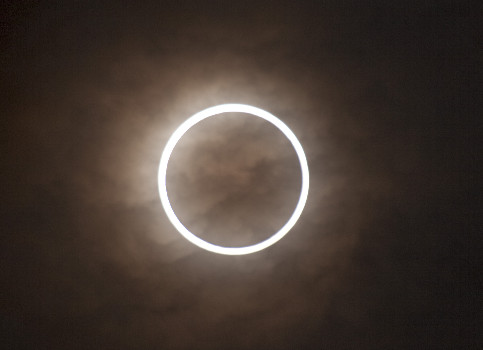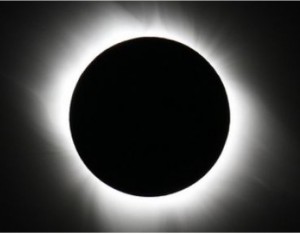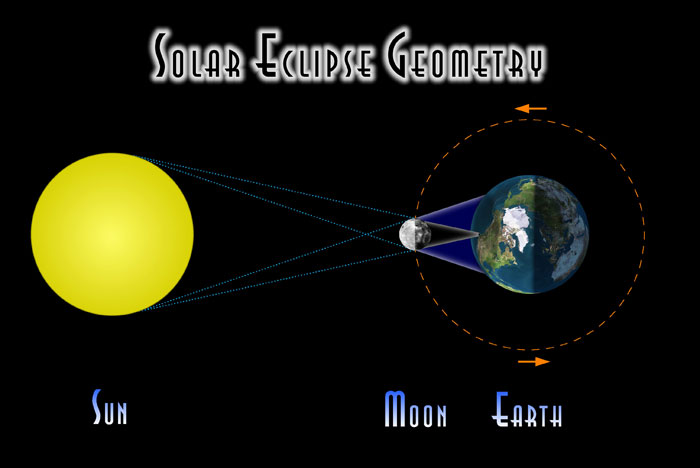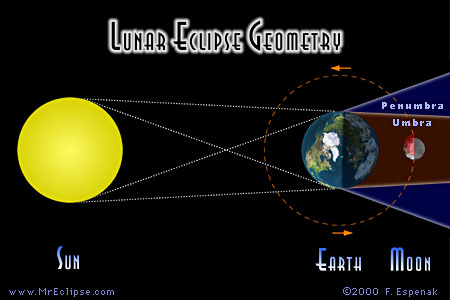Eclipses can take on a few different forms, namely Solar Eclipses, Lunar Eclipses, Annular and Total Solar Eclipses. Here is an explanation of all the various types of eclipse.
Solar Eclipse and Lunar Eclipse, what is the difference?
Solar and lunar eclipses both involve the Earth, the Moon and the Sun. The positioning of all of these three bodies determines the eclipse type. A solar eclipse is when the Moon moves in front of the Sun as viewed from the Earth, blocking the Sun’s light. A Lunar eclipse occurs when the Moon moves in to the Earth’s shadow (i.e. The Earth is located directly between the Moon and the Sun thereby blocking the Sun’s light from reflecting back off of the full Moon).
First we’ll explain the three different types of solar eclipse; Partial, Annular and Total solar eclipses…
Solar Eclipses
Partial Solar Eclipses
 This type of eclipse is witnessed during the build up to a total solar eclipse, annular solar eclipse or just during an eclipse that will only ever be partial. Often seen from a large area of Earth, these types of solar eclipses are seen more often than any. In the case of the American eclipse in 2017, the whole of North America will be able to see this stage of the eclipse. This is mainly due to the fact that the Moon’s distance from Earth is irrelevant to us on Earth during these events. If a partial eclipse is going to happen, a big chunk of Earth will witness it. Appearing to take a ‘bite’ out of the Sun, the Moon obscures the Sun’s disc. During sunrise or sunset, partial eclipses can be quite picturesque.
This type of eclipse is witnessed during the build up to a total solar eclipse, annular solar eclipse or just during an eclipse that will only ever be partial. Often seen from a large area of Earth, these types of solar eclipses are seen more often than any. In the case of the American eclipse in 2017, the whole of North America will be able to see this stage of the eclipse. This is mainly due to the fact that the Moon’s distance from Earth is irrelevant to us on Earth during these events. If a partial eclipse is going to happen, a big chunk of Earth will witness it. Appearing to take a ‘bite’ out of the Sun, the Moon obscures the Sun’s disc. During sunrise or sunset, partial eclipses can be quite picturesque.
As the illustration later below shows, a partial eclipse is observed from Earth when it is in the Moon’s outer shadow or ‘Penumbra’. The ever-so-slight darkening caused by the ‘Penumbral Shadow’ is hardly noticeable. It’s the point between full sunlight and complete shadow from the Moon. The Sun’s light is so brilliant that even when partially obscured, it is difficult to notice a darkening in surrounding light (despite the obvious ‘bite’ of the Sun in the sky). Even when 60% obscured, things can seem normal.
Annular Solar Eclipse
 An annular solar eclipse is much more rare than a partial solar eclipse. Even though a partial eclipse is seen by many during these events, the annular phase is only seen in a narrow corridor across the Earth. What causes the ‘ring in the sky’ is down to the elliptical orbit of the Moon. There are times when the new moon is located further away from Earth than at other times. The point at when it is furthest away is called ‘apogee’. If a full eclipse of the sun happens around this time, an annular solar eclipse is witnessed due to the Moon appearing slightly smaller than the Sun. This means that the main shadow of the Moon, the umbra, does not reach the Earth, allowing sunlight to peer around the complete circumference of the Moon.
An annular solar eclipse is much more rare than a partial solar eclipse. Even though a partial eclipse is seen by many during these events, the annular phase is only seen in a narrow corridor across the Earth. What causes the ‘ring in the sky’ is down to the elliptical orbit of the Moon. There are times when the new moon is located further away from Earth than at other times. The point at when it is furthest away is called ‘apogee’. If a full eclipse of the sun happens around this time, an annular solar eclipse is witnessed due to the Moon appearing slightly smaller than the Sun. This means that the main shadow of the Moon, the umbra, does not reach the Earth, allowing sunlight to peer around the complete circumference of the Moon.

During these events, a noticeable darkening of the sky can be seen but not to the dramatic extent that a total solar eclipse can.
Total Solar Eclipse
 On to what will happen on July 02, 2019, a total solar eclipse is the rarest of the three solar eclipse types mentioned. In order for this event to happen, the Moon must be at new phase and not be near apogee in its orbit around the Earth. Much like the annular eclipse, only a select few will be able to witness the event in a narrow corridor which stretches across the Earth from West to East. Most area’s of the Earth will be located outside of this ‘path of totality’. However, a much larger area of Earth will be able to see the partial phase of the eclipse as the illustration below shows.
On to what will happen on July 02, 2019, a total solar eclipse is the rarest of the three solar eclipse types mentioned. In order for this event to happen, the Moon must be at new phase and not be near apogee in its orbit around the Earth. Much like the annular eclipse, only a select few will be able to witness the event in a narrow corridor which stretches across the Earth from West to East. Most area’s of the Earth will be located outside of this ‘path of totality’. However, a much larger area of Earth will be able to see the partial phase of the eclipse as the illustration below shows.

Lunar Eclipses
Penumbral Lunar Eclipse
 Penumbral lunar eclipses are very subtle and can sometimes go unnoticed depending on how deep they go in to the penumbra. During these eclipses the Moon only ‘brushes’ with the Earth’s outer shadow. Of course these are witnessed as the first stages of a partial or total lunar eclipse as well but sometimes lunar eclipses occur that are only ever penumbral. A very slight darkening of one side of the full Moon is seen which then slowly progresses around the edge of the Moon before a full Moon is restored.
Penumbral lunar eclipses are very subtle and can sometimes go unnoticed depending on how deep they go in to the penumbra. During these eclipses the Moon only ‘brushes’ with the Earth’s outer shadow. Of course these are witnessed as the first stages of a partial or total lunar eclipse as well but sometimes lunar eclipses occur that are only ever penumbral. A very slight darkening of one side of the full Moon is seen which then slowly progresses around the edge of the Moon before a full Moon is restored.
Partial Lunar Eclipse
 Partial lunar eclipses can be seen during the build up to a total lunar eclipse or when there is an eclipse of the Moon that will only ever be partial. The Moon enters the penumbra and then part of the Earth’s primary shadow called the umbra but this shadow does not completely cover the Moon. There is an illustration of these two shadows further down the page. Only the Earth’s outer shadow (the Penumbra) covers all of the Moon making the full Moon more dimmer. The side of the Moon in the Umbra will darken quite considerably as shown in the image above.
Partial lunar eclipses can be seen during the build up to a total lunar eclipse or when there is an eclipse of the Moon that will only ever be partial. The Moon enters the penumbra and then part of the Earth’s primary shadow called the umbra but this shadow does not completely cover the Moon. There is an illustration of these two shadows further down the page. Only the Earth’s outer shadow (the Penumbra) covers all of the Moon making the full Moon more dimmer. The side of the Moon in the Umbra will darken quite considerably as shown in the image above.
Total Lunar Eclipse
 This is what will be witnessed on 20-21 January 2019. The Moon will first move in to the Earth’s outer shadow (penumbra) then passes right in to the Earth’s central shadow (Umbra). The full Moon will darken considerably once it reaches this phase. Below is an illustration showing the two shadows cast by the Earth and how the Moon’s position creates these different types of lunar eclipse.
This is what will be witnessed on 20-21 January 2019. The Moon will first move in to the Earth’s outer shadow (penumbra) then passes right in to the Earth’s central shadow (Umbra). The full Moon will darken considerably once it reaches this phase. Below is an illustration showing the two shadows cast by the Earth and how the Moon’s position creates these different types of lunar eclipse.

How often do eclipses happen?
Solar Eclipses
It’s commonplace to hear that solar eclipses are rare. However, on average there are 2.4 solar eclipses every year visible from somewhere on the Earth. This number includes the 3 types of solar eclipse mentioned above, total, annular and partial. A total solar eclipse is visible from somewhere on Earth approximately every 18 months. It is rare to witness a total solar eclipse as the total phase of the eclipse is only visible from a narrow corridor across the Earth’s surface. Therefore, to witness a total solar eclipse without travelling far to see it is considered rare.
Lunar Eclipses
Lunar eclipses are more common and are visible 2 to 4 times a year from somewhere on Earth. Lunar eclipses are also visible from a much larger geographical area of Earth for as long as the Moon is risen in the sky during the time of the eclipse, anyone can witness it, regardless of location (weather permitting). This effectively means around half the planet can witness some part of the eclipse. The total phase of the eclipse lasts much longer by comparison to the few minutes of a total solar eclipse. The total phase of an eclipse of the Moon can often last up to an hour or more with the whole eclipse lasting over 3 hours.
